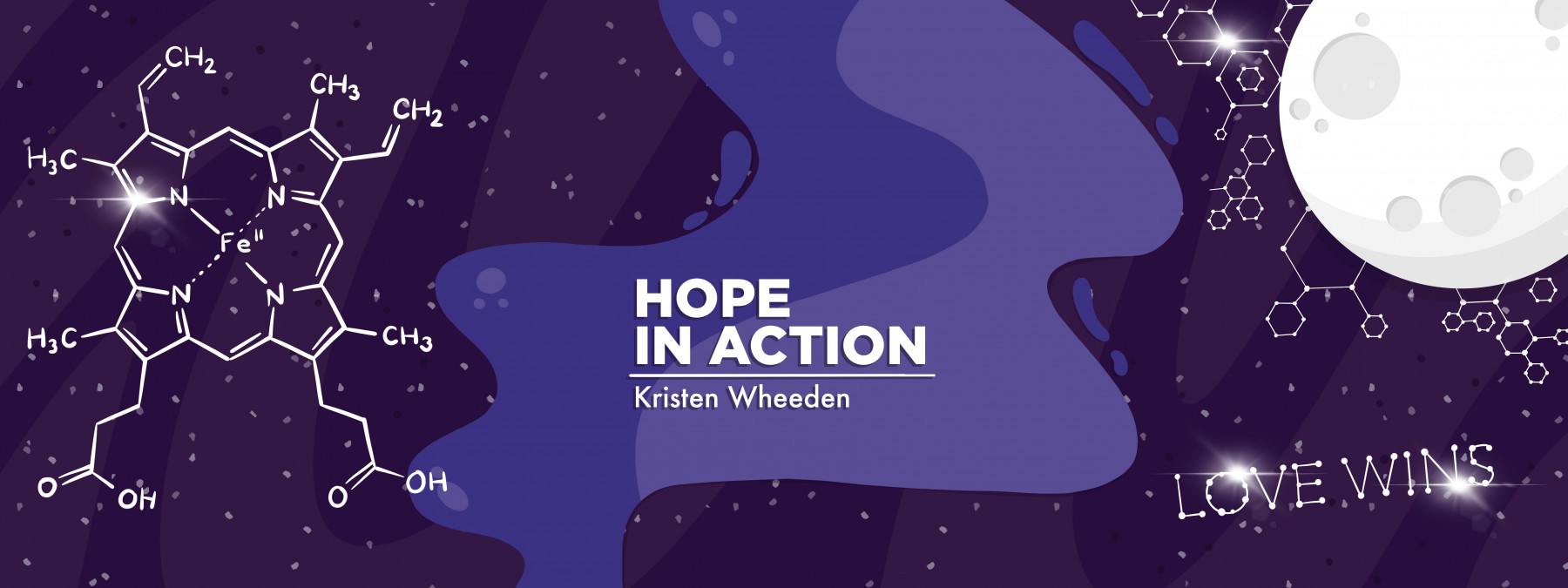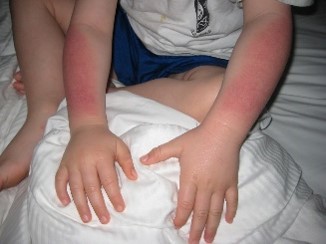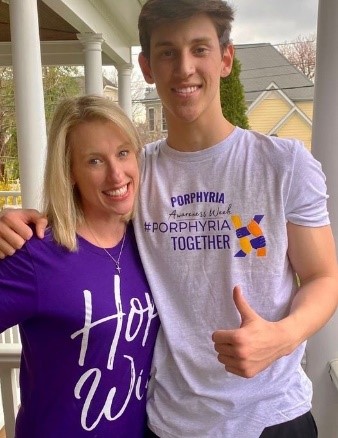Our Porphyria Journey: How It Started, How It’s Going
Written by |

My 16-year-old son Brady agreed to pop on a #PorphyriaTogether T-shirt and pose with Mom for last Friday’s #PurpleForPorphyria global event in honor of Porphyria Awareness Week 2022. I am a happy mom anytime he cozies up to me.
The resulting image took my breath away. Staring at me was this tall, smiling, beautiful soul. My mind flashed through time as I thought about how far he has come. A trip down memory lane and through years of photos brought me back to the beginning of this porphyria journey. It reminded me of Maya Angelou’s wisdom: “You can’t really know where you are going until you know where you have been.”
How it started

Brady’s erythropoietic protoporphyria journey begins in 2009, at the age of 4, when a vacation in the sun turned into a “week of hell.” (Courtesy of Kristen Wheeden)
In 2009, at age 4, Brady was diagnosed with erythropoietic protoporphyria (EPP), a rare disease that causes phototoxic reactions to the sun. Mere hours at a pool on the first day of vacation turned into a week of hell with a toddler that was writhing inconsolably and unable to sleep or find the words to share that his body was burning from the inside out. I cringe at the “sun protective” shirt he wore that day. EPP requires full-body protection, and a thin, sleeveless T-shirt barely counts as a barrier.
All Brady had to show for his manic behavior were slightly red arms. A trip to the emergency room produced more questions than answers. EPP is mostly invisible, making it difficult to attract clinical suspicion for testing. Although he was diagnosed within months of that episode, he has lived through years of unimaginable pain from unintended exposure.

Brady’s arms turn red, one of the few visible signs at the time of erythropoietic protoporphyria, in 2009. (Courtesy of Kristen Wheeden)
That day at the pool long ago is the last time Brady ever felt free outdoors. After paying a terrible price in pain, the goal becomes to constantly avoid it. “Shadow jumping,” a term that describes EPPers who “jump” between shady patches of safety, is Brady’s way of life now for protection from the sun’s brutal rays.
How it’s going
After Brady’s diagnosis, we formed a community that became our support system. We educated other family members. His two older brothers became his best friends and fiercest allies.
We met people with all types of porphyria who know this disease and were willing to share their expertise. Recently, a fellow EPPer sought intel about the disease by consulting his “EPP family.” And that is exactly what we are: family.
This family also includes porphyria specialists, the clinicians and researchers whose work means everything to us. I’ve even had the professional opportunity to co-author peer-reviewed publications with some of them, including a patient-reported outcome study of the prodromal, or initial, symptoms of an EPP reaction. That study, titled “Erythropoietic protoporphyria: time to prodrome, the warning signal to exit sun exposure without pain-a patient-reported outcome efficacy measure,” was published last year in the journal Genetics in Medicine.
Living with a rare disease brings many challenges. Yet the burden is lighter when you can count on family, friends that become family, and a team of professionals.
Brady is driving — which is more difficult than you might imagine — and thriving as a junior in high school. He secured a summer job and volunteers to support others with his disease. He still hugs his mom and dad every day.
We have always hoped that our journey would help others on their own path. I am blessed to have that opportunity every single day in my role as president of the United Porphyrias Association. There are thousands of patients with all types of porphyria to support, including those who are undiagnosed.

Thumbs-up: Brady and Kristen don purple shirts to mark Porphyria Awareness Week in April. (Courtesy of Kristen Wheeden)
One of my last calls the night before I wrote this column was from a mom who was finally able to have her child correctly tested for and diagnosed with EPP after struggling for years. Within the space of a few hours, I connected her with a world-renowned specialist who picked up the phone to answer her many questions. She quickly secured an appointment with someone I had waited years to meet.
I shared with her something I wish I had been able to tell myself 13 years ago: Life will be different, but it will be great. This disease will bring pain, but also opportunity. Your son will learn courage, resilience, character, and time management. You will find an expanded family that understands him and has your back.
Take every opportunity to teach him to self-advocate and protect himself. There is a team behind the scenes with researchers, physicians, pharmaceutical partners, and advocates, all uniting to make his life better. Let him experience his emotions and love him when he is feeling down. Then pick him up and offer the hope of a bright future.
I’m in this with you because we are #PorphyriaTogether.
Note: Porphyria News is strictly a news and information website about the disease. It does not provide medical advice, diagnosis, or treatment. This content is not intended to be a substitute for professional medical advice, diagnosis, or treatment. Always seek the advice of your physician or other qualified health provider with any questions you may have regarding a medical condition. Never disregard professional medical advice or delay in seeking it because of something you have read on this website. The opinions expressed in this column are not those of Porphyria News or its parent company, Bionews, and are intended to spark discussion about issues pertaining to porphyria.







Carolyn Aune
I would like to know the name(s) of physicians that are porphyria specialists. Suffering from symptoms for almost thirty years, many er emergency episodes, yet no doctor is willing to test. It’s dismissed because it’s a rare disease. It may be rare but it does exist, right? Why is the patient made to feel that they want to be in the cohort with a “designer” disease.
Please, if anyone would tell me where to turn for help, let me know.
Thanks
Carolyn
Kristen Wheeden
Hi Carolyn - There is a significant delay in diagnosis that we are trying to close. United Porphyrias Association will be glad to support you. Please email [email protected], call 800-868-1292 and head to www.porphyria.org for testing information. The good news is that you do not need to go to a specialist for the correct testing. We can educate your doctor and create a consult with a specialist if needed. Doctors don't often expect to see a rare disease patient...but we hear many times that "rare is not rare," as there are 7000 known rare disease impacting nearly 30 million Americans alone!
Phyllis Schwarz
Kristen,
My now 23 year old son has suffered from what I believe is EPP since 5th grade. By the time I researched many avenues based upon his symptoms going from doctor to doctor, he was 16 when he was tested at the Mayo Clinic in Arizona per the testing methods recommended by Dr. Linda Ede with the Porphyria Center, UT in Galveston. The results came back border line and thus they determined he did not have EPP and there was nothing they could do.
He continued to suffer severe pain in his hands, feet, and face (back of neck) and swelling after exposure to the sun causing him to go to the ER a couple of times for relief. He was prescribed an EPI pen in case his symptoms became worse and that was all they could do. He has missed so many sporting events which was devastating to an athletic boy. Even today, he has gone on summer vacations with friends only to end up in his hotel room trying desperately to cool down the burning, stinging pain after a short time on the beach. I am sure you are all too familiar with this with you son.
I am now catching up on new treatments (Scenesse) to help extend the time spent in the sun for those affected by EPP. I also have read how you need to have a diagnosis of EPP in order to be prescribed any of the new treatments. I am at a loss as to where to turn to request testing for my son. And if he is tested and it comes back as borderline again, but he still suffers the unbearable symptoms, then I believe he would be a good candidate for the oral medication, Prenumbra, which can be dosed according to severity of symptoms.
Do you have any suggestions on where to start?
Thank you!
Phyllis
Kristen Wheeden
Phyllis - I am so sorry that your son is suffering. As a fellow mom, I feel your heartbreak too.
Please contact United Porphyrias Association at [email protected] or 800-868-1292 for testing information. You'll see that there are two labs in the US that test for EPP correctly. Typically, a diagnosis would be required for treatment with a specific therapeutic.